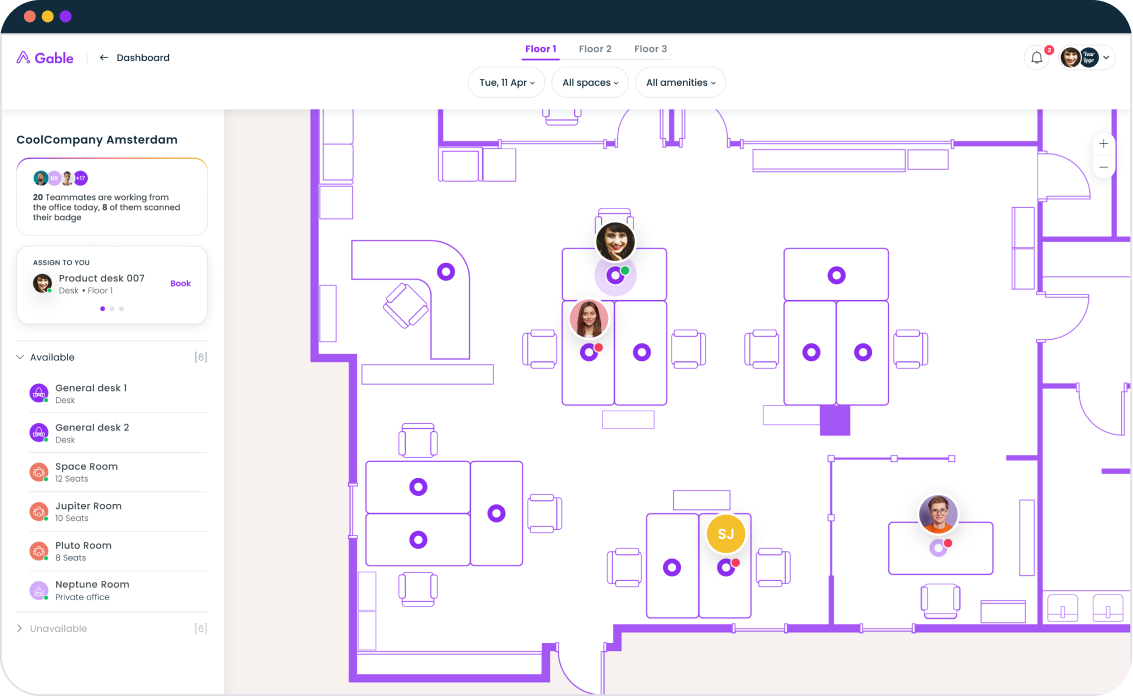An IWMS is a platform that allows organizations to manage their physical spaces, assets, and resources from a single place. But with the global IWMS market projected to grow to $13.4 billion by 2033, the question is which approach will work best for your organization.
The modern workplace landscape looks something like this: 64% of organizations now operate on hybrid models, and 68% of enterprises are increasing investment in digital facilities. To navigate flexible work, employee needs, and business outcomes, workplace leaders need Integrated Workplace Management Systems (IWMS).
In this guide, we'll give you the practical insights you need to understand IWMS, evaluate its benefits, and determine if it's right for your workplace strategy.
What is an IWMS (Integrated Workplace Management System)?
An Integrated Workplace Management System (IWMS) is a software platform that centralizes the management of an organization's real estate portfolio, facilities, and workplace resources into a single, unified system. Originally defined by Gartner in 2004, IWMS platforms integrate five core functional areas that traditionally operated in silos.
Think of an IWMS as the central nervous system for your physical workplace. Instead of juggling multiple point solutions for space management, maintenance tracking, lease administration, and project management, an IWMS provides one platform where facilities managers, real estate experts, and workplace teams can collaborate effectively.
The five core IWMS functional areas include:
Real Estate Management: Property acquisition, lease management, portfolio analysis, and transaction management that help organizations optimize their real estate investments and maintain regulatory compliance.
Space Management: Floor plan management, space allocation, occupancy tracking, and move management that ensures optimal space utilization across facilities while supporting hybrid work models.
Maintenance Management: Asset lifecycle management, work order processing, preventive maintenance scheduling, and vendor management to minimize downtime and extend asset life through streamlined workflows.
Capital Project Management: Project planning, budgeting, resource management, and timeline management for facility improvements and expansions using data-driven decisions.
Energy Management: Energy consumption monitoring, carbon footprint tracking, sustainability efforts, and compliance management to reduce costs and meet environmental goals.

See how Snowflake consolidated three workspace services into one unified platform, eliminating hundreds of setup hours and reducing costs.
Read Case Study
Modern IWMS solutions have evolved beyond these traditional functions. According to Verdantix research, 80% of executives considering IWMS software identify user interface quality as the most critical decision factor, reflecting how these systems now prioritize employee experience alongside operational efficiency.
The business case for IWMS
The numbers tell a compelling story. Real estate and facility management costs typically represent more than 20% of a company's total expenses, making them prime targets for optimization. Yet many organizations still manage these critical functions through multiple systems and manual processes.
The current workplace reality
Today's workplace leaders face a perfect storm of challenges that IWMS platforms directly address:
Hybrid work complexity: With 75% of leaders expecting to change their work models soon, traditional space planning approaches no longer work. Organizations need real-time data to make informed decisions about their real estate portfolio management.
Rising facility costs: Facilities management costs have increased significantly, driven by inflation, labor shortages, and supply chain challenges. Without proper visibility and control through IWMS systems, these costs will continue to escalate.
Sustainability pressures: 63% of US companies now rely on IWMS for environmental and energy management tracking as ESG requirements become more stringent and energy usage optimization becomes critical.
The measurable impact of IWMS implementation
Organizations that implement IWMS platforms report significant improvements across multiple metrics:
Cost reduction: Research shows IWMS deployment leads to a 14% reduction in facility maintenance costs, 40% improvement in workspace management, and 42% increase in facility usage efficiency.
Operational efficiency: 72% of facilities management leaders report improved operational transparency after IWMS deployment, enabling faster decision-making and better resource management.
Predictive maintenance ROI: 95% of predictive maintenance adopters report positive ROI, with 27% achieving payback in less than one year through reduced equipment downtime and optimized maintenance scheduling.
Space optimization: Organizations use IWMS data to rightsize their real estate portfolios, with some reporting reductions of 30-50% in underutilized space through better visibility and space planning.
Key benefits of implementing an IWMS
The advantages of IWMS extend far beyond simple software consolidation. Here's how these platforms create measurable value for organizations:
Centralized data and decision-making
An IWMS eliminates the data fragmentation that plagues most facility operations. Instead of pulling reports from multiple solutions, decision-makers access a single technology platform that combines real estate data, maintenance records, space utilization metrics, and financial management information.
This centralization enables scenario planning that was previously impossible. Workplace leaders can model the impact of lease agreements, space reconfigurations, or new workplace policies before making commitments, reducing risk and improving outcomes.
Enhanced space utilization and planning
With 54% of businesses prioritizing space optimization and energy efficiency, IWMS platforms provide the visibility needed to make data-driven space decisions. Real-time occupancy tracking, booking analytics, and space efficiency reporting help organizations understand how their office spaces are used versus planned capacity.
This data becomes critical for hybrid workplace strategies. Instead of guessing about optimal office capacity or desk-to-employee ratios, facilities teams can base decisions on actual usage patterns and employee preferences, optimizing space while supporting workplace collaboration.
Streamlined maintenance and asset management
Traditional reactive maintenance approaches are expensive and disruptive. IWMS platforms enable preventive maintenance strategies that prevent failures before they occur. McKinsey research shows predictive maintenance can reduce equipment downtime by up to 50% and lower maintenance costs by 10% to 40%.
The software platform tracks asset lifecycle management, maintenance history, and warranty information in one place, enabling better vendor management and more strategic transaction management decisions.
Empower employees to book desks and rooms effortlessly while gaining real-time insights into space utilization.
Learn More
Improved compliance and risk management
Regulatory compliance becomes manageable when all relevant data lives in one system. IWMS platforms track safety certifications, environmental compliance, lease accounting obligations, and audit requirements, providing automated alerts when action is needed to maintain regulatory compliance.
For organizations with multiple facilities, this centralized compliance tracking reduces the risk of oversights that could result in fines or operational disruptions.
IWMS vs. point solutions: Making the right choice
The decision between an integrated IWMS solution and specialized point solutions depends on organizational size, complexity, and strategic priorities.
When IWMS makes sense
Multiple locations: Organizations with more than 50,000 square feet or multiple facilities typically benefit from IWMS integration. The complexity of managing diverse facilities across different markets requires centralized coordination and capital planning.
Complex operations: Companies with significant maintenance requirements, regulatory compliance needs, or active capital project management portfolios find value in integrated workflows and shared data across functional areas.
Strategic real estate focus: Organizations viewing real estate as a strategic asset rather than just a cost center benefit from IWMS analytics and scenario planning capabilities for portfolio management.
Hybrid workplace initiatives: Companies implementing flexible work policies need integrated space management and employee experience tools that traditional facility management solutions don't provide.
The hybrid approach
Many organizations start with IWMS software modules and gradually expand into comprehensive platforms as their needs become more complex. This approach allows for incremental investment while building internal capabilities and change management experience through the implementation process.
The key is ensuring that initial solutions can integrate with future IWMS platforms, avoiding data migration challenges that complicate later consolidation efforts.
IWMS implementation: Best practices for success
With 68% of enterprises implementing or planning IWMS adoption, implementation best practices have become well-established. Successful deployments follow a structured approach that prioritizes business processes over technical features.
Strategic planning and stakeholder alignment
Start with clear business objectives that connect IWMS capabilities to organizational goals. Whether the focus is cost reduction, operational efficiency, or employee experience improvement, these objectives guide software selection and implementation priorities.
Stakeholder engagement is critical. IWMS implementations affect facilities managers, real estate managers, finance teams, and employees. Early involvement ensures buy-in and reduces resistance during deployment.
Platform selection and data preparation
Evaluate IWMS solutions based on functional fit, not just feature lists. The right IWMS solution aligns with your specific business processes and integrates with existing enterprise systems.
Data preparation often takes longer than expected. Most IWMS implementations require accurate CAD drawings, organizational hierarchy data, and user lists. Starting this process early prevents deployment delays.
Phased deployment and optimization
Deploy functionality in phases rather than attempting full implementation at once. Start with the most critical functions where you can demonstrate quick wins, building momentum for broader adoption.
Invest heavily in training and change management. User interface quality is the most critical factor in IWMS success, but even intuitive IWMS platforms require proper training to achieve adoption goals.
After initial deployment, focus on data analysis and process optimization. IWMS software generates valuable, actionable insights that weren't available with previous systems. Use this data to streamline processes and identify additional opportunities.
The future of IWMS: Trends shaping the next generation
The IWMS market is evolving rapidly, driven by technological advances and changing workplace requirements.
AI and predictive analytics integration
Gartner research indicates that by 2025, over 50% of industrial companies will have adopted AI-driven predictive maintenance, fundamentally changing how IWMS platforms operate. These capabilities extend beyond maintenance to space optimization, energy management, and workplace experience personalization.
Modern IWMS platforms use machine learning to predict space demand, optimize maintenance scheduling, and recommend workplace improvements based on usage patterns and employee feedback.
IoT and smart building integration
The integration of IoT sensors with IWMS platforms creates real-time visibility into facility operations that was previously impossible. Occupancy sensors, environmental monitors, and asset management tracking devices feed data directly into IWMS systems, enabling automated responses and more accurate analytics.
This integration supports hybrid workplace strategies by providing real-time occupancy data that helps employees find available spaces and helps facilities teams understand actual space demand, supporting both workplace resources optimization and enhanced productivity.
Employee experience focus
IWMS solutions are becoming more employee-oriented, expanding their focus to include all building occupants and visitors. Modern platforms include mobile apps, self-service portals, and integration with collaboration tools that improve the workplace experience while providing valuable data to facilities teams.
See how Gable helps organizations supercharge space management, reduce costs, and create a top-notch employee experience.
Get a Demo





.svg)





.svg)










.svg)













